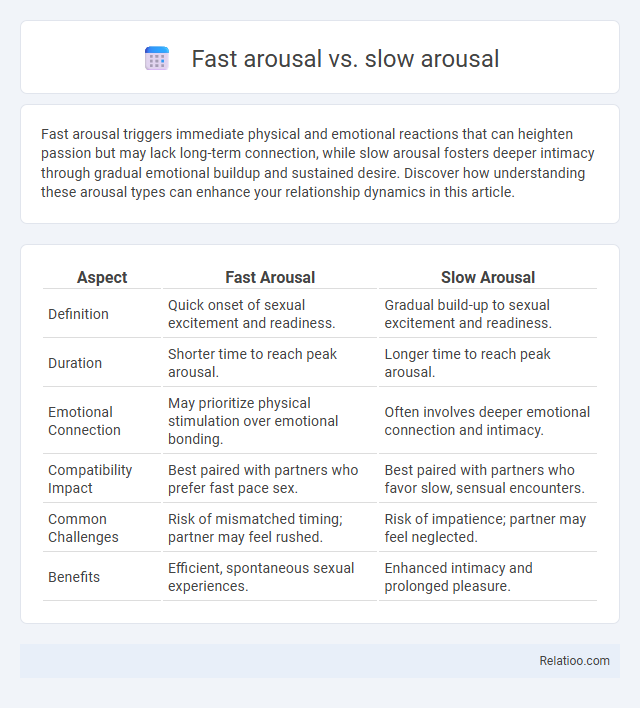Fast arousal triggers immediate physical and emotional reactions that can heighten passion but may lack long-term connection, while slow arousal fosters deeper intimacy through gradual emotional buildup and sustained desire. Discover how understanding these arousal types can enhance your relationship dynamics in this article.
Table of Comparison
| Aspect | Fast Arousal | Slow Arousal |
|---|---|---|
| Definition | Quick onset of sexual excitement and readiness. | Gradual build-up to sexual excitement and readiness. |
| Duration | Shorter time to reach peak arousal. | Longer time to reach peak arousal. |
| Emotional Connection | May prioritize physical stimulation over emotional bonding. | Often involves deeper emotional connection and intimacy. |
| Compatibility Impact | Best paired with partners who prefer fast pace sex. | Best paired with partners who favor slow, sensual encounters. |
| Common Challenges | Risk of mismatched timing; partner may feel rushed. | Risk of impatience; partner may feel neglected. |
| Benefits | Efficient, spontaneous sexual experiences. | Enhanced intimacy and prolonged pleasure. |
Understanding Fast Arousal: Definition and Characteristics
Fast arousal refers to a rapid physiological and psychological response triggered by sudden stimuli, characterized by immediate alertness and heightened sensory perception. This type of arousal activates the sympathetic nervous system, leading to swift increases in heart rate, respiration, and adrenaline release. Understanding fast arousal is crucial for recognizing how the body prepares for quick reactions to potential threats or opportunities in the environment.
The Science Behind Slow Arousal
Slow arousal involves a gradual increase in physiological and psychological sexual excitement, allowing for prolonged pleasure and deeper emotional connection compared to fast arousal, which spikes quickly and may dissipate just as fast. The science behind slow arousal highlights the role of sustained blood flow, neural activation, and hormonal responses, particularly involving dopamine and oxytocin, which enhance intimacy and overall satisfaction. Understanding slow arousal can help you develop better self-awareness and improve sexual experiences by focusing on mindfulness and patience during intimate moments.
Psychological Factors Influencing Arousal Speed
Psychological factors such as stress levels, cognitive appraisal, and emotional state play a crucial role in determining fast arousal versus slow arousal responses. Your brain's interpretation of stimuli activates the autonomic nervous system at varying speeds, influenced by anxiety, attention, and prior experiences. Understanding these elements helps manage how quickly arousal occurs, optimizing performance and emotional regulation.
Biological Triggers: Fast vs. Slow Arousal
Biological triggers of fast arousal involve immediate activation of the sympathetic nervous system, releasing adrenaline to prepare your body for quick responses such as the fight-or-flight reaction. Slow arousal engages parasympathetic pathways, gradually increasing physiological readiness through hormonal changes like cortisol release, often linked to prolonged stress or anticipation. Understanding these distinct mechanisms helps optimize your response to stimuli by balancing rapid alertness with sustained focus.
Emotional Impact of Different Arousal Styles
Fast arousal triggers an immediate, intense emotional response, heightening Your senses and creating a burst of excitement or anxiety. Slow arousal builds emotional tension gradually, allowing for deeper emotional processing and prolonged engagement. Understanding these styles helps tailor emotional experiences for enhanced connection and impact.
Relationship Dynamics and Arousal Compatibility
Fast arousal often leads to intense but short-lived passion, while slow arousal fosters deeper emotional connection and long-lasting intimacy, influencing relationship dynamics significantly. Your arousal compatibility with a partner affects how well your emotional and physical needs align, impacting satisfaction and mutual understanding. Balancing fast and slow arousal patterns can enhance communication, intimacy, and overall relationship harmony.
Strategies for Enhancing Slow Arousal
Slow arousal strategies focus on gradually increasing physiological and psychological readiness through techniques like deep breathing, mindfulness meditation, and progressive muscle relaxation, which promote sustained sexual responsiveness. Incorporating sensory exploration and extended foreplay enhances slow arousal by heightening sensitivity and emotional connection, leading to a more fulfilling experience. Slow arousal benefits from creating a relaxed environment, reducing distractions, and encouraging open communication to increase comfort and anticipation.
Common Myths About Fast and Slow Arousal
Common myths about fast and slow arousal often confuse physiological speed with intensity, incorrectly assuming fast arousal always indicates stronger emotional response and slow arousal weaker reaction. Research clarifies that arousal speed reflects individual differences in autonomic nervous system activation and does not directly determine the quality or duration of emotional experience. Understanding these distinctions helps debunk misconceptions linking arousal velocity to emotional control or health outcomes.
When to Seek Help: Arousal Disorders and Solutions
Arousal disorders, including fast arousal and slow arousal types, can significantly impact daily functioning and quality of life, necessitating professional evaluation when symptoms persist or cause distress. Fast arousal may manifest as heightened sensitivity or anxiety, while slow arousal might present as difficulty initiating or sustaining attention and responsiveness, both requiring tailored therapeutic approaches. Seeking help from neurologists or mental health specialists is crucial for accurate diagnosis and to implement effective treatments such as cognitive-behavioral therapy, medication, or lifestyle modifications.
Embracing Diversity in Sexual Arousal Patterns
Sexual arousal manifests in diverse patterns, including Fast Arousal characterized by rapid onset, Slow Arousal marked by gradual development, and variable Arousal encompassing a spectrum of responses. Embracing this diversity acknowledges that individuals experience and express sexual desire differently, influenced by physiological, psychological, and contextual factors. Recognizing and validating Fast and Slow Arousal patterns fosters inclusive approaches in sexual health, therapy, and relationship dynamics, promoting better communication and satisfaction.

Infographic: Fast Arousal vs Slow Arousal
 relatioo.com
relatioo.com